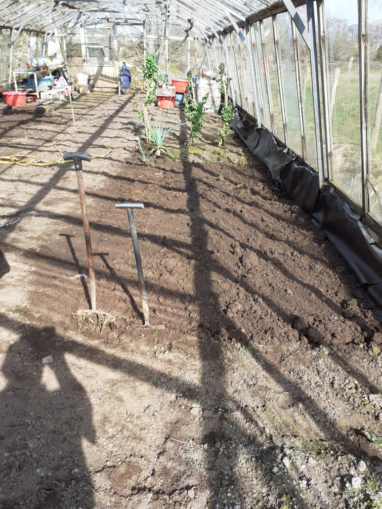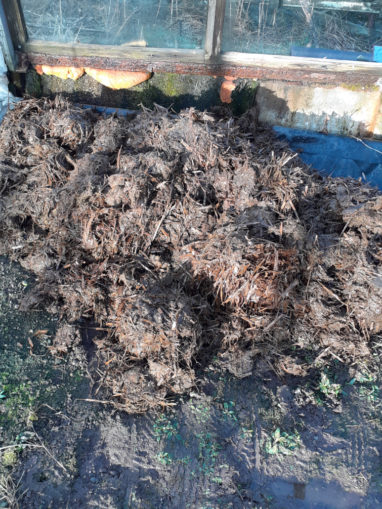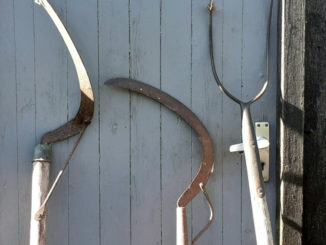It’s no secret that I inherited a large, rickety old greenhouse from an ex commercial grower who just happened to be my Father-in-Law. In the 12 years or so since I moved to Cumbria and took it over I’ve turned from a reluctant gardener, who saw mowing the grass twice a year as the limit of his gardening ambitions, into a self taught and passionate grower of vegetables and fruits. The house I use was once exclusively given over to tomato growing and in terms of volume that’s still the main crop, although I keep trying different things with differing degrees of success. No two years are the same and no two growing seasons either, but over the coming months I’d like to take you with me as I prepare, manage and produce my crops.
Preparing The Ground

© Colin Cross, Going Postal 2020
The first job I take care of, every season, is the preparation of the soil. I have a rotovator but I also like to dig the earth myself, it’s good exercise and there’s a certain satisfaction to be derived from turning the sods. I’ve settled on a compromise with myself, I rotovate and hand dig on a bi-annual cycle although the trenches for the potato stitches and the central tomato trench have to be formed by the application of manual labour. Digging started a little later than usual this year, the inordinate amount of rain, which runs off the fields and under the greenhouse had left the soil very muddy in large areas, consequently I left it a couple of weeks longer than usual to let it dry out a bit. The above picture is of the area where I’ll be planting my peas. I don’t trench this section, I turn it over, scatter organic chicken manure over it, damp it down and turn it over a second time. I’ve found, over the years and to my cost in terms of crop, that the cow manure which I use for potatoes and tomatoes is a little too rich for my peas. The light application of the chicken manure seems to work well, although this may be as much to do with the soil as anything else. I had potatoes in this section last year, so there will be a residue of cow manure. Although I rotate everything but the tomatoes I’ve never planted the peas on the same area where potatoes have been the previous year. I’ll start putting peas in next week and hopefully we’ll get a decent crop.
The Muck

© Colin Cross, Going Postal 2020
A cattle and sheep farmer who live a couple of villages away rents the fields that surround my little plot for sheep grazing. Every year he delivers me about a ton of fresh cow manure, which he tips in the yard and which I have to barrow along a short narrow path to the house. It’s a job that requires some coordination, it can’t be left lying too long before being moved, sun will dry it out and rain will wash nutrients out of it. I generally shift it within a day or two of it getting dropped off. It makes a good all round fertiliser for brassica’s and squashes as well as the ubiquitous potatoes and tomatoes. Beets, onions and leeks also benefit from a light application which I spread over the tilled soil, soak with water and dig in. Although muck is my fertiliser of choice, both because of it’s cost (a few pounds of tomatoes) and the fact that it’s close to organic it isn’t always available. Soil improvers and other fertilisers are available from garden centres if you don’t know a freindly farmer.
The Trenches

© Colin Cross, Going Postal 2020
The final job of the initial preparation phase is to dig the trenches ready for the fertiliser to be utilised and, in the case of the potatoes to get them in the ground. I used to plant potatoes lengthwise along the house in two long stitches, about two feet apart but in the last couple of years, although I still put in around 30 seed, I tend to put in more varieties in shorter rows. This year I’ve put in Charlotte, Pink Fir Apple, Arran Pilot, Rocket and some King Edwards. I’ve had success with all these types before apart from the Fir Apple, this being the first year I’ve tried them. Once these trenches are dug, about a foot wide and about 15 inches deep I put muck in to about 5 inches deep, soak it thoroughly until the water sits just below the surface and put the seed directly onto the muck making sure a good shoot is facing upwards before replacing the earth and doming slightly. I water hard at this point but am sparing with it (water) as the season progresses, too much water will result in poor cropping. If you’re planting potatoes and using a bought fertiliser I’d recommend getting it in the ground a couple of weeks before planting. My method won’t work in every case.

© Colin Cross, Going Postal 2020
The technique for the tomato trench, all 60 feet of it, is broadly the same process but once the muck is in and drenched I replace the earth and let the magic happen. The tomatoes don’t go in until maybe the third week in April, although a keen eye needs to be kept on the weather. Tomato plants are susceptible to even slight changes in temperature and they’re also quite slow from germination to being mature enough to plant out, even under glass. Veg can be grown just about everywhere (where there’s soil), glass isn’t essential, but if you’re going to be growing tomatoes, chillies and the like then a conservatory, if you haven’t got a greenhouse is an ideal place to start. Growbags are okay as are pots, so long as they’re big enough to ensure enough space for the root to form and do its work. There’s an old boy in the village who sticks a couple of seed potatoes in amongst his chrysanthemums. He always gets a decent crop off them. Who knows, in these straightened times, he might well be onto something. Here’s a though too, I work alone, I walk to the greenhouse alone and I mind my own little corner. Archetypal Social Distancing.
Next time we’ll take a look at seeds, compost, propagation and plants. I’m no Percy Thrower, but if you have a specific question I’m sure you can find a way to get it to me, maybe we could resurrect one of the forums?
Happy rough gardening.
© Colin Cross 2020
The Goodnight Vienna Audio file



